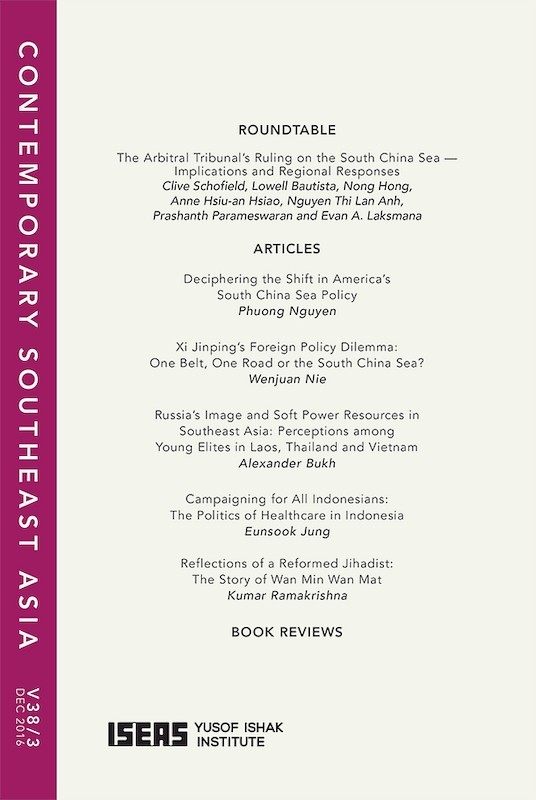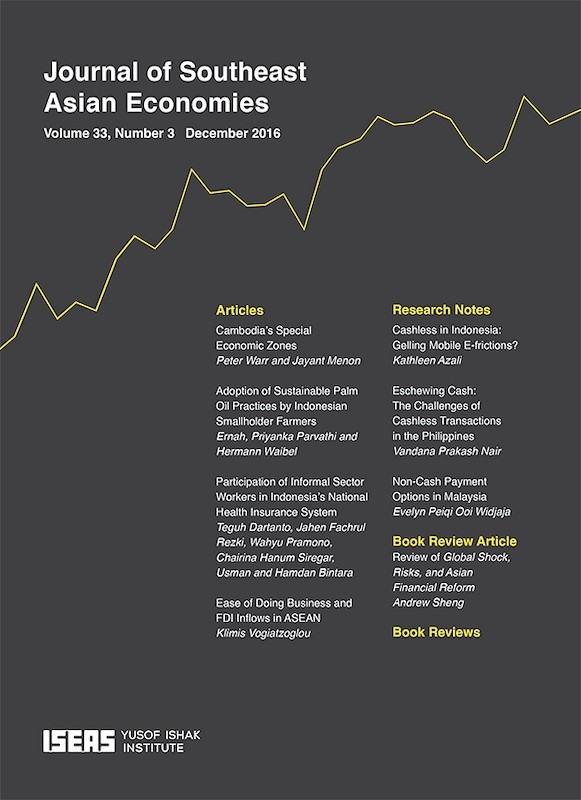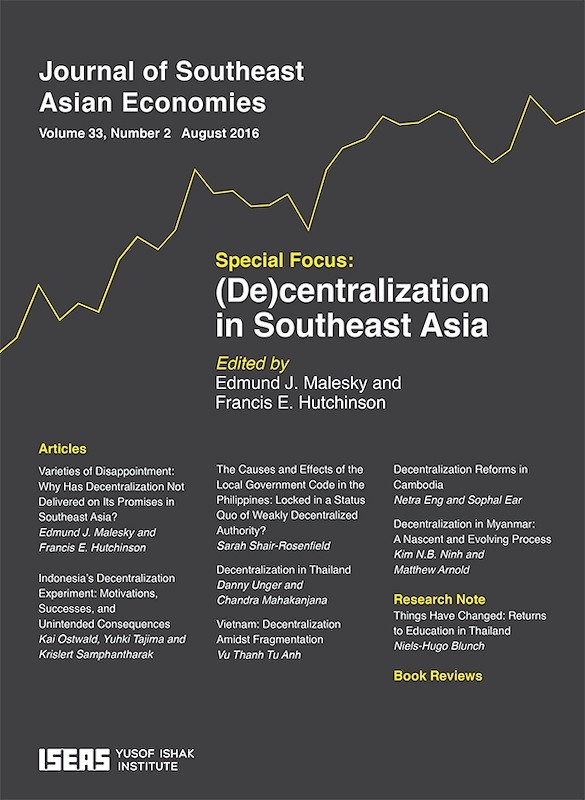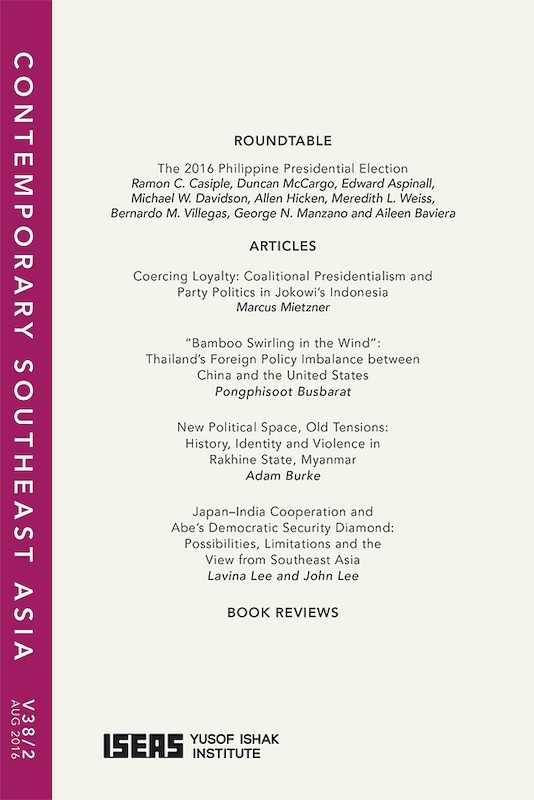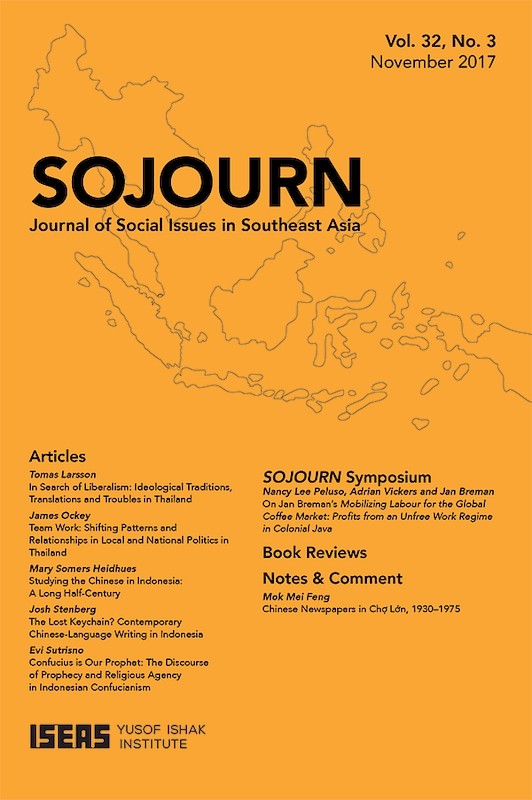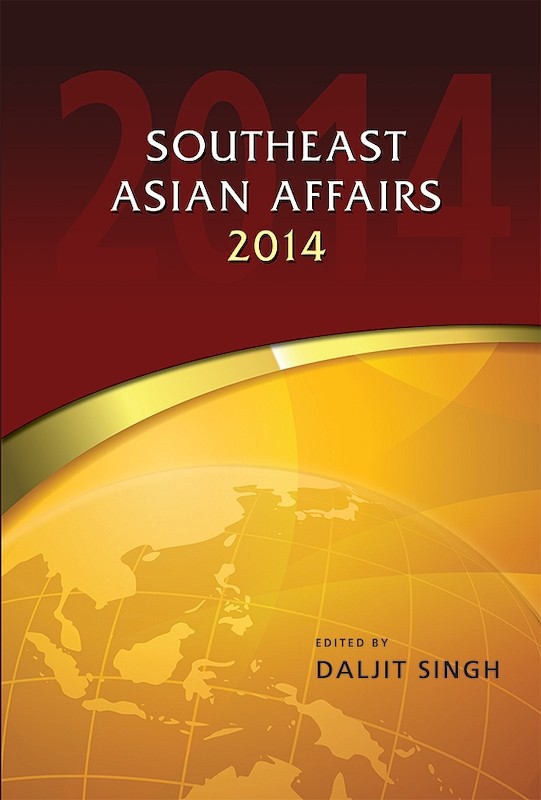SOJOURN: Journal of Social Issues in Southeast Asia Vol. 31/3 (November 2016)
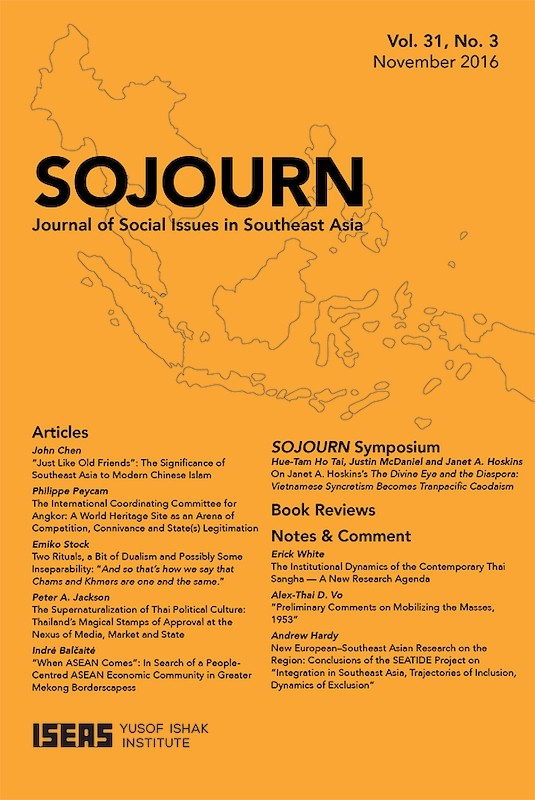
Michael J Montesano, editor
Date of publication:
November 2016
Publisher:
ISEAS – Yusof Ishak Institute
Number of pages:
373
Code:
SJ31/3
Contents
-
SOJOURN: Journal of Social Issues in Southeast Asia Vol. 31/3 (November 2016)
[Whole Publication, ISSN: 17932858] -
Preliminary pages
- ARTICLES
-
"Just Like Old Friends": The Significance of Southeast Asia to Modern Chinese Islam, by John Chen, author see abstractDuring China's Republican era (1911–49), amid increasing contacts with Southeast Asia, Chinese Muslims crafted politically useful narratives of Sino-Islamic maritime exchange and Islam's contributions to Chinese civilization. Two examples stand out in particular: Bai Shouyi's scholarship on the Song-era <i>materia medica</i> trade and the government-sponsored Chinese Islamic South Seas Delegation's wartime mission to Malaya. In both cases, Chinese Muslims asserted their connectedness not only to the Chinese nation-state and the Arab Middle East but also to the Islamic world as a whole. Southeast Asia's significance for modern Chinese Islam lay in providing an inspiration and a destination for these travelling civilizational narratives.
-
The International Coordinating Committee for Angkor: A World Heritage Site as an Arena of Competition, Connivance and State(s) Legitimation, by Philippe Peycam, author see abstract<div><font face="helvetica, arial, verdana, sans-serif"><span style="font-size: 13px;">To what extent has the system of international cooperation established </span></font><span style="font-size: 13px; font-family: helvetica, arial, verdana, sans-serif;">to manage the UNESCO “World Heritage Site” of Angkor through </span><span style="font-size: 13px; font-family: helvetica, arial, verdana, sans-serif;">the “International Coordination Committee for the Safeguarding of </span><span style="font-size: 13px; font-family: helvetica, arial, verdana, sans-serif;">the Historic Site of Angkor” succeeded in coordinating and mediating </span><span style="font-size: 13px; font-family: helvetica, arial, verdana, sans-serif;">international and national state interests in the conservation and </span>development of the site and those of the communities living near it? A series of programmes aimed at spatial transformations of the “Angkor region” featured crucial French and Japanese roles in framing the committee’s activities and its interactions with the Cambodian authorities. Representatives of both the committee and UNESCO made self-legitimizing claims asserting the success of their work as a model of international cooperation for the safeguarding of World Heritage Sites. But can a proper mechanism of cooperation for the safeguarding of a major heritage site be realized, or sustained, without the effective participation of the communities living in and around these sites?</div>
-
Two Rituals, a Bit of Dualism and Possibly Some Inseparability: "And so that's how we say that Chams and Khmers are one and the same.", by Emiko Stock, author see abstract<div><font face="helvetica, arial, verdana, sans-serif"><span style="font-size: 13px;">Scholarship on Muslims in Cambodia often revolves around a series of </span></font><span style="font-size: 13px; font-family: helvetica, arial, verdana, sans-serif;">cultural, religious and social contrasts between Champa and Cambodia, </span><span style="font-size: 13px; font-family: helvetica, arial, verdana, sans-serif;">between Chams and Khmers. Yet such an approach depends in turn on </span><span style="font-size: 13px; font-family: helvetica, arial, verdana, sans-serif;">an apprehension of ethnic boundaries as given, fixed, and permanent. </span><span style="font-size: 13px; font-family: helvetica, arial, verdana, sans-serif;">Consideration of two Cham rituals suggests a more nuanced perspective. </span><span style="font-size: 13px; font-family: helvetica, arial, verdana, sans-serif;">These rituals are the Imam San Mawlid, a Muslim saint’s anniversary, </span><span style="font-size: 13px; font-family: helvetica, arial, verdana, sans-serif;">and the <i>Mamun</i>, a possession ceremony to invite royal spirits. While </span><font face="helvetica, arial, verdana, sans-serif">both events are said to celebrate Cham culture and history, Khmer </font>elements make the flexibility, the porosity and the fluidity of identities finally rendered illusive, if not inseparable.</div>
-
The Supernaturalization of Thai Political Culture: Thailand's Magical Stamps of Approval at the Nexus of Media, Market and State, by Peter A Jackson, author see abstract<div><font face="helvetica, arial, verdana, sans-serif"><span style="font-size: 13px;">Since the 1980s, new supernatural movements have become highly </span></font><span style="font-size: 13px; font-family: helvetica, arial, verdana, sans-serif;">visible additions to Thailand’s spiritual <br>landscapes and religious </span><span style="font-size: 13px; font-family: helvetica, arial, verdana, sans-serif;">marketplaces. Focused on supernatural intervention to bring success, </span><span style="font-size: 13px; font-family: helvetica, arial, verdana, sans-serif;">wealth and prosperity in Thailand’s expanding economy, these </span><span style="font-size: 13px; font-family: helvetica, arial, verdana, sans-serif;">movements are often only tangentially related to orthodox Theravada </span><span style="font-size: 13px; font-family: helvetica, arial, verdana, sans-serif;">Buddhist teachings and practice. These highly commodified wealth-oriented </span><span style="font-size: 13px; font-family: helvetica, arial, verdana, sans-serif;">movements emerged in the context of Thailand’s economic </span><span style="font-size: 13px; font-family: helvetica, arial, verdana, sans-serif;">boom in the 1980s and 1990s, and have continued to grow in popularity </span><span style="font-size: 13px; font-family: helvetica, arial, verdana, sans-serif;">and develop further through the 1997 Asian economic crisis and the </span><span style="font-size: 13px; font-family: helvetica, arial, verdana, sans-serif;">political conflicts that have destabilized Thai society over the past </span><span style="font-size: 13px; font-family: helvetica, arial, verdana, sans-serif;">decade. The large number of colourful special issues of Thai postage </span><span style="font-size: 13px; font-family: helvetica, arial, verdana, sans-serif;">stamps devoted to supernatural cults of prosperity released since </span><span style="font-size: 13px; font-family: helvetica, arial, verdana, sans-serif;">2004 reflects the relocation of these movements from the margins to </span><span style="font-size: 13px; font-family: helvetica, arial, verdana, sans-serif;">the centre of national religious practice. These stamp special issues </span><span style="font-size: 13px; font-family: helvetica, arial, verdana, sans-serif;">also reflect a major shift in the regime of power over public imaging <br></span><span style="font-size: 13px; font-family: helvetica, arial, verdana, sans-serif;">that depicts the participation of Thailand’s economic, political and </span><span style="font-size: 13px; font-family: helvetica, arial, verdana, sans-serif;">royal elites in new forms of supernatural ritual. This ritual has now </span><span style="font-size: 13px; font-family: helvetica, arial, verdana, sans-serif;">been incorporated into state projects under the aegis of officially </span><span style="font-size: 13px; font-family: helvetica, arial, verdana, sans-serif;">sponsored Theravada Buddhism. No longer kept hidden or private, </span><span style="font-size: 13px; font-family: helvetica, arial, verdana, sans-serif;">elite participation in supernatural ritual is becoming an </span>increasingly <br>visible and politically significant dimension of the symbolism and exercise of power in early twenty-first-century Thailand.</div>
-
"When ASEAN Comes": In Search of a People-Centred ASEAN Economic Community in Greater Mekong Borderscapes, by Indrė Balčaitė, author see abstractEthnographic snapshots from borderscapes in the Greater Mekong Subregion suggest that the information campaign to promote ASEAN Economic Community, with its promise of open borders from the end of 2015 onward, had reached the borderlanders. But the region's borders, though transgressed daily, remained firmly in place. These snapshots raise questions concerning whether anything was in fact opening up; if so, what was opening up; and for whom it was opening up. Limited agreements, whose implementation has lagged, promise to facilitate tourism, large-scale trade and the cross-border employment of skilled personnel, but national governments continue to manage the heavy flows of low-skilled migrants tightly.
- SOJOURN SYMPOSIUM
-
The Divine Eye and the Diaspora: Vietnamese Syncretism Becomes Transpacific Caodaism. By Janet A. Hoskins. Review essays by Hue-Tam Ho Tai and Justin McDaniel, with a response from Janet A. Hoskins, by Hue-Tam Ho Tai, Justin McDaniel, Gareth Hoskins, authors
- BOOK REVIEWS
-
BOOK REVIEW: Sidewalk City: Remapping Public Space in, Ho Chi Minh City by Annette M. Kim, by Danielle Labbe, author
-
BOOK REVIEW: Frontier Livelihoods: Hmong in the Sino-Vietnamese Borderlands by Sarah Turner, Christine Bonnin, and Jean Michaud, by Alexander Horstmann, author
-
BOOK REVIEW: Human Trafficking in Colonial Vietnam by Micheline Lessard, by Isabelle Tracol-Huynh, author
-
BOOK REVIEW: The Political Development of Modern Thailand by Federico Ferrara, by Michael J Montesano, author
-
BOOK REVIEW: Unequal Thailand: Aspects of Income, Wealth and Power by Pasuk Phongpaichit and Chris Baker, by Amrita Danière, author
-
BOOK REVIEW: Thailand's International Meditation Centers: Tourism and the Global Commodification of Religious Practices by Brooke Schedneck, by Erick White, author
-
BOOK REVIEW: "Getting By": Class and State Formation among Chinese in Malaysia by Donald M. Nonini, by Hans-Dieter Evers, author
- NOTES AND COMMENT
-
The Institutional Dynamics of the Contemporary Thai Sangha A New Research Agenda, by Erick White, author see abstractStudies of the Thai sangha as an institution have fallen out of academic fashion in recent decades, despite the fact that during this same time Thai public life has been characterized by widespread organizational ferment and innovation. Accordingly, a renewed and reoriented analysis of the organizational milieux underpinning everyday monastic life is overdue. Nine themes worth examining in research on the monastic order as a public institution are proposed. The empirical and analytic benefits of a revitalized research agenda along these lines are then discussed, as well as the demographic, geographic and social factors that should be taken into consideration when pursuing such research.
-
Preliminary Comments on Mobilizing the Masses, 1953, by Alex-Thai D Vo, author see abstractModelled after the Chinese experience, the land reform undertaken by the Democratic Republic of Vietnam of 1953–56 is perhaps the most important domestic policy of the Vietnamese Communist revolution. Because of a scarcity of primary sources, however, very little is known about the influence of Chinese advisors on this policy. Luo Guibo's recommendations on mobilizing the masses to carry out land reform are one of the very few known documents drafted by a leading Chinese advisor to the Hanoi government. Translating and making this document available makes possible a rare glimpse of the Chinese perspective on and assessment of the situation in Vietnam in the early 1950s. It also illuminates one aspect of the influential role of Chinese advisors in Sino–Vietnamese relations during that decade, especially in the controversial land reform campaign.
-
New European–Southeast Asian Research on the Region: Conclusions of the SEATIDE Project on "Integration in Southeast Asia, Trajectories of Inclusion, Dynamics of Exclusion", by Andrew Hardy, author see abstract<div><font face="helvetica, arial, verdana, sans-serif"><span style="font-size: 13px;">SEATIDE brought together fifty researchers from nine European </span></font><span style="font-size: 13px; font-family: helvetica, arial, verdana, sans-serif;">and Southeast Asian institutions to research national and regional </span><span style="font-size: 13px; font-family: helvetica, arial, verdana, sans-serif;">integration in Southeast Asia. Its conclusions examine the impact of </span><span style="font-size: 13px; font-family: helvetica, arial, verdana, sans-serif;">the region’s past on its present, including the colonial and Cold War </span><span style="font-size: 13px; font-family: helvetica, arial, verdana, sans-serif;">periods, and the persistence of pre-colonial principalities as cultural </span><span style="font-size: 13px; font-family: helvetica, arial, verdana, sans-serif;">regions. Nation-building is analysed in the light of assimilation </span><span style="font-size: 13px; font-family: helvetica, arial, verdana, sans-serif;">policies, while borders, transnationalism and connectivity are the focus </span><span style="font-size: 13px; font-family: helvetica, arial, verdana, sans-serif;">of discussion of regional integration. Other themes include mobility, </span><span style="font-size: 13px; font-family: helvetica, arial, verdana, sans-serif;">gender and work; development models and the environment; state </span><span style="font-size: 13px; font-family: helvetica, arial, verdana, sans-serif;">centrality, human security and the “ASEAN integration conundrum”; </span><span style="font-size: 13px; font-family: helvetica, arial, verdana, sans-serif;">and an “integration/exclusion nexus” showing that integration involves </span><span style="font-size: 13px; font-family: helvetica, arial, verdana, sans-serif;">exclusions by its very nature.</span></div>

